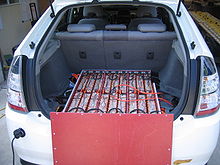Electric Mobility/Battery
This learning resources focuses on electric mobility and dependency on a sustainable durable support for that technology.

Subtopics
editIn general there are 3 types energy supply:
- Battery Charge: connect the vehicle to electricity supply network and charge the battery or renewable energy (e.g. solar cells) are used to charge the battery.
- Battery Exchange: An empty battery will be exchanged or filled battery can be attached to vehicle (e.g. for extending the range). Even exchange the car can be an option to avoid long charging time (e.g. car sharing network)
- Battery Refill: A fluid, gas or solid matter is carrier of the energy for vehicle
Learning Task
edit- (Battery Charging and Capacity) What is the current capacity of battery technology and current charging times?
- (Baghdad Battery) Explore when the first battery was found in archeology in Baghdad?
- (Personal Requirements) Define a performance parameters for yourself, at what price, what distance a battery capacity would the battery serve your needs!
- (Battery Life Time) What is the life time of battery and how does that contribute to the total cost of ownership and what are the cost per month!
- (Long Distance Challenge) rapid charging, exchange of the battery or attach extra batteries for long distances can be approaches for the electric energy supply for the vehicles! Explore current scientific and technological developments as submodules of this learning resources.
- (Resource for Batteries) Lithium can be imported e.g. from Chile. Explore the mining situation and the environmental impact of the Lithium mining.
- (Fuel Cells) Fuels cells work with hydrogen. What are the options to generate hydrogen and how much greenhouse gas is generated for hydrogen and how much energy is currently use with regenerative energy? Will be possible to use solar energy to generate hydrogen?